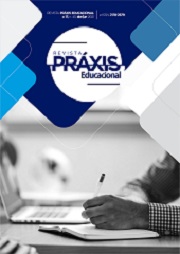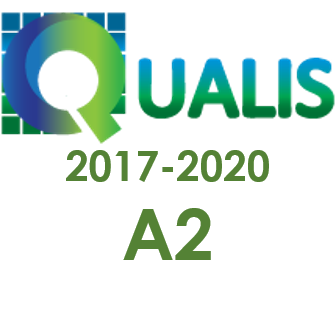Mecânica de jogo em narrativa para apoio de alunos com dislexia: percepções de discentes e docentes
DOI:
https://doi.org/10.22481/praxisedu.v17i45.8345Palavras-chave:
Narrativa gamificada, Mecânicas de jogo, Aprendentes com dislexiaResumo
Este artigo apresenta o processo de desenvolvimento e testagem de um protótipo de uma narrativa gamificada, que visa apoiar a aprendizagem de leitura de alunos com dislexia. Motivação, engajamento e aprendizagem foram os domínios medidos a partir das perspectivas dos participantes coletados por meio de escalas e entrevistas abertas. Os dados das entrevistas foram registrados em áudio após a testagem do recurso e, posteriormente, transcritos e analisados por meio da técnica análise de conteúdo. Quanto as escalas, estas foram aplicadas após a testagem. São apresentados o processo de design, destacando o framework e os princípios e estratégias de game utilizados. Os resultados principais mostram indicadores da contribuição dos elementos de jogo aplicados ao recurso para os domínios avaliados.
Downloads
Metrics
Referências
ALVES, F. Gamification: como criar experiências de aprendizagem engajadoras. São Paulo: DVS Editora, 2014.
BARDIN, L. Análise de conteúdo. 4ª. ed. Lisboa: Edições 70, 2009.
CARROL, M. P. Shoot For The Moon! The Mentors and the Middle Schoolers Explore the Intersection of Design Thinking and STEM. In: Journal of Pre-College Engineering Education Research, v. 4, n. 1, 2014. Disponível em: https://docs.lib.purdue.edu/cgi/viewcontent.cgi?article=1072&context=jpeer. Acesso em 20 abr. 2019.
CARVALHAIS, L. Construção de Instrumentos de Avaliação da Dislexia. 375 f. Tese (Doutorado em Psicologia da Educação) – Departamento de Ciência da Educação, Universidade de Aveiro, Aveiro, 2010.
COUTINHO, C. Metodologia de investigação em ciências sociais e humanas: teoria e prática. 2. ed. Coimbra: Edições Almedina, 2016.
DETERDING, S.; DIXON, D.; KHALED, R.; NACKE, L. From game design elements to gamefulness: Defining gamification. In: MINDTREK 2011, 11., 2011, Tampere. Anais […]. Tampere: DBLP 2011. p. 9-15. Disponível em: https://dblp.org/db/conf/mindtrek/mindtrek2011. Acesso em 20 de abr. de 2019.
DIANA, J.; GOLFETTO, I.; BALDESSAR, M.; SPANHOL, F. Gamification e teoria do flow. In: FADEL, M.; ULBRIGHT, R.; BATISTA, R.; VANZIN, T. (eds.). Gamificação na Educação. São Paulo: Pimenta Cultural, 2014.
FRANCESCHINI, S.; GORI, S.; RUFFINO, M.; VIOLA, S.; MOLTENI, M.; FACOETTI, A. Action Video Games Make Dyslexic Children Read Better. In: Current Biology, n. 23, v.6, p. 462–466. Doi:10.1016/j.cub.2013.01.044. Acesso em 13 de abr. 2019.
GAGGI, O.; GALIAZZO, G.; PALAZZI, C.; FACOETTI, A.; FRANCESCHINI, S. A Serious Game for Predicting the Risk of Developmental Dyslexia in Pre-Readers Children. In: Anais […] (ICCCN), 2012. https//:doi:10.1109/icccn.2012.6289249. Acesso em 30 de mar. 2018.
GOOCH, D., VASALOU, A., BENTON, L., KHALED, R. Using Gamification to Motivate Students with Dyslexia, 2016. Disponível em: https://www.researchgate.net/publication/291116195_Using_Gamification_to_Motivate_Students_with_Dyslexia. Acesso em: 17 mar. 2017.
KAPP, K.; BLAIR, L.; MESCH, R. The gamification of learning and instruction: game-based methods and strategies for training and education. São Francisco: Wiley & sons, 2014.
KAPP, K. The Gamification of Learning and Instruction Field book: into Practice. São Francisco: John Wiley & Sons, 2013.
Kronk, H. Dyslexia dragon develops a gamified platform to help learners read and spell. Elearning Inside. 2018. Disponível em: https://news.elearninginside.com/dyslexia-dragondevelops-gamified-platform-help-learners-read-spell/. Acesso em 14 de ag. 2019.
LI, W.; GROSSMAN, T.; FITZMAURICE, G. Gamicad Tutorial system for first time AutoCAD users. In: Anais do UIST’12, Massachusetts: Cambridge, 2012. Disponível em: https://www.researchgate.net/publication/262333846_GamiCAD_A_gamified_tutorial_system_for_first_time_AutoCAD_users/link/57. Acesso em 20 de abr. 2019.
MARQUES, D. A. O Jogo no Desenvolvimento da Criança Disléxica. Dissertação de Mestrado em Ciências da Educação na Especialização em Educação Especial: Domínio Cognitivo e Motor. Escola Superior de Educação João de Deus, Lisboa, 2014.
MUNTEAN, C. Raising engagement in e-learning through gamification. In: Anais […], Bucharest, 2011, p. 323-329. Disponível em: https://www.academia.edu/36387149/Raising_engagement_in_e_learning_through_gamification. Acesso em 14 de mai. 2018.
RELLO, L.; BALLESTEROS, M.; ALI, A.; SERRA, M.; SÁNCHEZ, D.; BIGHAM, J. Dytective: Diagnosing Risk of Dyslexia with a Game, 2016. https://doi: 10.1145/1235. Acesso em 20 de abr. 2019.
RELLO, L., BAYARRI, C.; GORRIZ, A. What is Wrong with this Word? Dyseggxia: A Game for Children with Dyslexia Categories and Subject Descriptors. In Anais […].,6–7. Disponível em:
http://www.luzrello.com/Piruletras_(Dyseggxia)_files/assets2012dyseggxia.pdf. Acesso em: 6 jun. 2018.
ROMINUS, M.; EKLUND, K.; PESU, L.; LYYTINEN, H. (Supporting struggling readers with digital game-based learning. In: Education Tech Research Dev, 67, 639–663, 2019. https://doi.org/10.1007/s11423-019-09658-3. Acesso em 12 de nov. 2019.
SAILER, J.; HENSE, H.; MANDL, H.; KLEVERS, M. Psychological Perspectives on Motivation through Gamification. In: Interaction Design and Architecture(s) Journal, n. 19, p. 28-37, 2013. Disponível em: https://core.ac.uk/download/pdf/26951671.pdf. Acesso em 13 de dez. 2020.
SAPUTRA, M. LexiPal: Design, Implementation and Evaluation of Gamification on Learning Application for Dyslexia. In: International Journal of Computer Applications, n. 131, v. 7, p. 0975-8887, 2015. Doi: https:// 10.5120/ijca2015907416. Acesso em 13 de dez. 2020.
SCHEER, A.; NOWESKI, C.; MEINEL, C. Transforming Constructivist Learning into Acion: Design Thinking in Education. In: Design and Technology Education: An International Journal, n. 17, v. 3, p. 8-12, 2012. Disponível em: https://files.eric.ed.gov/fulltext/EJ996067.pdf. Acesso em: 6 jun. 2018.
SCHIMITZ, B., KLEMKE, R., SPECHT, M. Effects of mobile gamifying patterns on learning outcomes: A literature review. In: Int. J. Technology Enhanced Learning, n. 4, v. 5/6, p. 345-358, 2012. Doi: https:// 10.1504/IJTEL.2012.051817. Acesso em 6 jun. 2018.
SIMÕES, J., REDONDO, R., VILAS, A. Using Flow as a Measurement of Students engagement in a Gamified Social Learning Environment. In: Anais do ICERI 2015, Sevilha, 2015., p. 0291-0301. Disponível em: https://library.iated.org/view/SIMOES2015USI. Acesso em 6 de jun. 2018.
WERBACH, K.; HUNTER, D. For the win: how game thinking can revolutionize your business. Filadélfia: Wharton Digital Press, 2012.
MARQUES, D. A. O Jogo no Desenvolvimento da Criança Disléxica. Dissertação de Mestrado em Ciências da Educação na Especialização em Educação Especial: Domínio Cognitivo e Motor. Escola Superior de Educação João de Deus, Lisboa, 2014.
MUNTEAN, C. Raising engagement in e-learning through gamification. In: Anais […], Bucharest, 2011, p. 323-329. Disponível em: https://www.academia.edu/36387149/Raising_engagement_in_e_learning_through_gamification. Acesso em 14 de mai. 2018.
RELLO, L.; BALLESTEROS, M.; ALI, A.; SERRA, M.; SÁNCHEZ, D.; BIGHAM, J. Dytective: Diagnosing Risk of Dyslexia with a Game, 2016. https://doi: 10.1145/1235. Acesso em 20 de abr. 2019.
RELLO, L., BAYARRI, C.; GORRIZ, A. What is Wrong with this Word? Dyseggxia: A Game for Children with Dyslexia Categories and Subject Descriptors. In Anais […].,6–7. Disponível em:
http://www.luzrello.com/Piruletras_(Dyseggxia)_files/assets2012dyseggxia.pdf. Acesso em: 6 jun. 2018.
ROMINUS, M.; EKLUND, K.; PESU, L.; LYYTINEN, H. (Supporting struggling readers with digital game-based learning. In: Education Tech Research Dev, 67, 639–663, 2019. https://doi.org/10.1007/s11423-019-09658-3. Acesso em 12 de nov. 2019.
SAILER, J.; HENSE, H.; MANDL, H.; KLEVERS, M. Psychological Perspectives on Motivation through Gamification. In: Interaction Design and Architecture(s) Journal, n. 19, p. 28-37, 2013. Disponível em: https://core.ac.uk/download/pdf/26951671.pdf. Acesso em 13 de dez. 2020.
SAPUTRA, M. LexiPal: Design, Implementation and Evaluation of Gamification on Learning Application for Dyslexia. In: International Journal of Computer Applications, n. 131, v. 7, p. 0975-8887, 2015. Doi: https:// 10.5120/ijca2015907416. Acesso em 13 de dez. 2020.
SCHEER, A.; NOWESKI, C.; MEINEL, C. Transforming Constructivist Learning into Acion: Design Thinking in Education. In: Design and Technology Education: An International Journal, n. 17, v. 3, p. 8-12, 2012. Disponível em: https://files.eric.ed.gov/fulltext/EJ996067.pdf. Acesso em: 6 jun. 2018.
SCHIMITZ, B., KLEMKE, R., SPECHT, M. Effects of mobile gamifying patterns on learning outcomes: A literature review. In: Int. J. Technology Enhanced Learning, n. 4, v. 5/6, p. 345-358, 2012. Doi: https:// 10.1504/IJTEL.2012.051817. Acesso em 6 jun. 2018.
SIMÕES, J., REDONDO, R., VILAS, A. Using Flow as a Measurement of Students engagement in a Gamified Social Learning Environment. In: Anais do ICERI 2015, Sevilha, 2015., p. 0291-0301. Disponível em: https://library.iated.org/view/SIMOES2015USI. Acesso em 6 de jun. 2018.
WERBACH, K.; HUNTER, D. For the win: how game thinking can revolutionize your business. Filadélfia: Wharton Digital Press, 2012.
Downloads
Publicado
Como Citar
Edição
Seção
Licença

Este trabalho está licenciado sob uma licença Creative Commons Attribution-ShareAlike 4.0 International License.
Você é livre para:
Compartilhar - copia e redistribui o material em qualquer meio ou formato; Adapte - remixe, transforme e construa a partir do material para qualquer propósito, mesmo comercialmente. Esta licença é aceitável para Obras Culturais Livres. O licenciante não pode revogar essas liberdades, desde que você siga os termos da licença.
Sob os seguintes termos:
Atribuição - você deve dar o crédito apropriado, fornecer um link para a licença e indicar se alguma alteração foi feita. Você pode fazer isso de qualquer maneira razoável, mas não de uma forma que sugira que você ou seu uso seja aprovado pelo licenciante.
Não há restrições adicionais - Você não pode aplicar termos legais ou medidas tecnológicas que restrinjam legalmente outros para fazer qualquer uso permitido pela licença.










